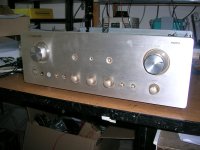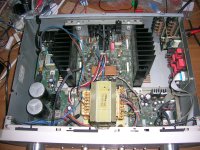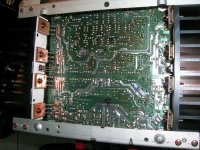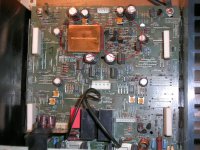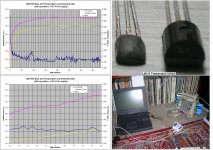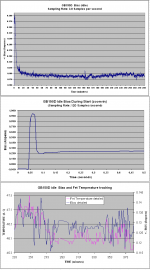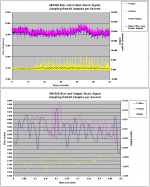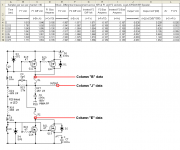Are audiophiles perhaps looking for the mystery and random reward system of the opposite sex, in something that is innately measurable and predictable like electronics?
As a trial, the manufacturer re-jigged one amp to employ a few dB of global NFB. THD fell to around 0.02%. I took part in blind listening tests. Not one tester liked the amp that employed some global NFB. That said, I did note that warm-up time (to optimum sound quality) was reduced dramatically. Probably a few seconds. I never measured it.
This comes round a lot. Both theory and measurements show that a small amount of negative feedback can make things worse. You need LOTS of feedback. Of course claiming 100dB NFB at 20Hz sends audiophiles scurrying like cockroaches when you turn the light on.
What if the issue is not temperature stability, but the time it takes to drive moisture out of capacitors, or some other unknown mechanism? Just sayin'
Hi Mark
Except the case of the old axial paper capacitors with aged tar or wax side shields, which other capacitor type does it absorb moisture from the environment for to become problematic?
All the AB class power amplifiers I’ve put at the bench and tested are DC bias sensitive to air movement inside the equipment enclosure. You can’t set the DC bias properly with lid open. DC bias has a perceived effect on sound.
An amplifier that I’ve seen was cautious in the thermal inertia and air mobility around sensitive circuit sections was a Marantz PM7200.
(three warm air cavities. Excellent construction for Bias stability, bad for long term reliability)
George
Attachments
simon7000 said he measured modern capacitors as having a break in time associated with moisture loss, and that it could be sped up by desiccation. If there is a way for moisture to get out, there may be a way for it to get back in. We don't know that at the moment. However, he measured a very small effect and there is more research that could be done. It's not that I suspect very small changes in capacitors to be the problem in the preamp we are taking about, I used the example of capacitors just to illustrate that unexpected things can sometimes be found and we don't necessarily know all the possible consequences without more research. We might be able to estimate a probability, sure, but there are still unexplained reports from people that claim to hear differences of unestablished origin. Personally, my opinion is that we are sometimes too quick to point the finger at cognitive bias or hallucinations. I would rather say we don't have a proven explanation yet, and defer judgement until we learn more. My reasons for that are largely anecdotal, all I can say is there is enough anecdotal evidence to convince me more new research should be done to better understand the brain's role in hearing. Right now our better understanding is for the role of ears.
Also, it has been known for a very long time that one can't prove a negative (that something can't happen) using examples of what has happened. However, with enough examples one may be able to calculate some statistics as to the probability, but not arrive at absolute proof. So, a few or even many examples of amplifiers that stabilize quickly can't prove that some other amplifier can't take longer to stabilize. If one did take a long time, the cause might be very unusual.
Also, it has been known for a very long time that one can't prove a negative (that something can't happen) using examples of what has happened. However, with enough examples one may be able to calculate some statistics as to the probability, but not arrive at absolute proof. So, a few or even many examples of amplifiers that stabilize quickly can't prove that some other amplifier can't take longer to stabilize. If one did take a long time, the cause might be very unusual.
Last edited:
I would say the performance amazed the first time listener more so than the spec sheet feature list.This amp was released in 1988.
The list of features amazed those of us who listened to it for the first time....
Tony Mills HiFi in Brisbane had a 1500 driving Duntech Sovereigns.
I did Tony's repairs back in the 90's and got to hear that setup regularly.
The only system that wowed me more was the big AR tube amps/Genesis 1 after spending a day installing and setting it up.
The ME/Duntech combo had that 'the search is over' factor in clarity, dynamics, depth and LR imaging and straight out enjoyment.
IME/IMO zero loop feedback amplifiers done right win hands down over high NFB designs, and provide 'realness' and 'comfort' in sound that is just not there with the usual fare.
I propose the mechanism is in how intrinsic/excess noise is handled.
Dan.
Last edited:
All the AB class power amplifiers I’ve put at the bench and tested are DC bias sensitive to air movement inside the equipment enclosure. You can’t set the DC bias properly with lid open. DC bias has a perceived effect on sound.
That strikes me as poor design... It's not impossible to make the amp without that sort of sensitivity.
Re the cap burn in, what type of caps are seemingly moisture sensitive? And, that would only matter if any parametric change that occurred mattered to the amp's performance.
Any amp that did need a long warm up time, should clearly say that in the user instructions, or have a lock out until it's ready to use like some old valved gear did.
Of course claiming 100dB NFB at 20Hz sends audiophiles scurrying like cockroaches when you turn the light on.
Of course one can easily name dozens of gobs of feedback amplifiers, even silly $1000's of dollar ones that have 10's of thousands of happy customers. Plenty here too.
Naturally, look at the the stereophile class A recommendations for Class D power amps! Just some people still hang on to the idea that it's bad.
That strikes me as poor design... It's not impossible to make the amp without that sort of sensitivity.
I haven’t said it is impossible.
It takes some consideration how the LP filtering (mechanical, electrical) will be performed.
Only monitor the temperature of the output transistors and the bias vs time, statically (amp in idle) and dynamically (playing music)
(an example of an open chassis, massive heat sink amplifier)
George
Attachments
George, how did you measure bias of Greg Ball's amplifier while playing music? Was zero crossing detector involved? Thank you
IME/IMO zero loop feedback amplifiers done right win hands down over high NFB designs, and provide 'realness' and 'comfort' in sound that is just not there with the usual fare.
I propose the mechanism is in how intrinsic/excess noise is handled.
When your only tool is a hammer, everything looks like a nail.
Do you have any analysis to support your proposal, or is it just the usual?
Finally somebody puts up a series of designs that make sense, audio quality wise.
Negative feedback is still a potential problem, no matter what anybody else thinks, yet I use it in ALL my amps, and most of my preamps. Only my very BEST designs do not use a feedback loop. They are the ones that work the best, and I am most known for.
However, in the real world, I cannot always make the 'very best' but instead the closest approximation to it. This includes Class AB outputs, loop feedback, IC's, etc.
I would like to remind everyone that it was Richard Heyser, in the late 1950's who discovered that negative feedback was a problem. He did not meet me until 1968, but he impressed this upon me then. Before that, I was a true loop feedback believer, just like most everybody else. He found the problem accidentally by listening, rather than measurement, and he told me for years: "If any two people can hear a sonic difference it is real!" I have come to agree with him on this.
Every excuse presented here why break-in is present is pointless. It exists without obvious bias problems as well. One just has to have a system that you are used to and an open mind with a good set of ears. IF I could remove break-in or even warm-up from being a sonic problem I would endeavor to do so, but I really don't know what causes it, and it is NOT my or my associates' imagination. We ignore it sometimes, only to be embarrassed by the sound quality at an audio show, for example, and then we resolve to make sure that we don't ignore it again next time. It is a matter of 'winning' sonically, not rationalizing that everything essentially sounds good. In any case, I am glad that a designer that I don't know know has similar thoughts on this subject and put his design efforts in this direction. I am not surprised why these amps are so highly regarded by their owners.
Negative feedback is still a potential problem, no matter what anybody else thinks, yet I use it in ALL my amps, and most of my preamps. Only my very BEST designs do not use a feedback loop. They are the ones that work the best, and I am most known for.
However, in the real world, I cannot always make the 'very best' but instead the closest approximation to it. This includes Class AB outputs, loop feedback, IC's, etc.
I would like to remind everyone that it was Richard Heyser, in the late 1950's who discovered that negative feedback was a problem. He did not meet me until 1968, but he impressed this upon me then. Before that, I was a true loop feedback believer, just like most everybody else. He found the problem accidentally by listening, rather than measurement, and he told me for years: "If any two people can hear a sonic difference it is real!" I have come to agree with him on this.
Every excuse presented here why break-in is present is pointless. It exists without obvious bias problems as well. One just has to have a system that you are used to and an open mind with a good set of ears. IF I could remove break-in or even warm-up from being a sonic problem I would endeavor to do so, but I really don't know what causes it, and it is NOT my or my associates' imagination. We ignore it sometimes, only to be embarrassed by the sound quality at an audio show, for example, and then we resolve to make sure that we don't ignore it again next time. It is a matter of 'winning' sonically, not rationalizing that everything essentially sounds good. In any case, I am glad that a designer that I don't know know has similar thoughts on this subject and put his design efforts in this direction. I am not surprised why these amps are so highly regarded by their owners.
He found the problem accidentally by listening, rather than measurement, and he told me for years: "If any two people can hear a sonic difference it is real!" I have come to agree with him on this.
🙂 😎
Its my learned experience as well. I said if many people from all walks of life and various systems over time hear the same thing, then it is real. Metadata results.
THx-RNMarsh
Last edited:
Agree with the conclusion. However, we know that any proper double blind testing trumps virtually any and all multivariate metadata analysis, in principle, and in terms of establishing a causal link. It would be much better if we could somehow make that research happen and start moving forward from there.
I said if many people from all walks of life and various systems over time hear the same thing, then it is real. Metadata results.
You do realize they are talking about your favorite ultra-low THD stuff?
George, how did you measure bias of Greg Ball's amplifier while playing music? Was zero crossing detector involved? Thank you
Hi Dimitri.
Differential voltage measurement across 10R/2W resistors soldered at F1 and F2 sockets (fuses removed). Amplifier’s load:JORDAN 6R Speaker.
I had used the cheapest DATAQ data acquisition unit.
Exported data to MS Excel
>Edit: At the diagrams of 3rd attachment,
“F1 Bias” is Column “C” data
“F2 Bias” is Column “G” data
George
Attachments
Hi Zaphod,
My own experiments agree with what Bill said. Small amounts of feedback do make things sound worse. As you increase the amount of feedback used, the design performs more poorly as the feedback is raised. Then you get to a point where increasing feedback improves performance. This trend continues as you increase feedback.
-Chris
My own experiments agree with what Bill said. Small amounts of feedback do make things sound worse. As you increase the amount of feedback used, the design performs more poorly as the feedback is raised. Then you get to a point where increasing feedback improves performance. This trend continues as you increase feedback.
My experiments show that it is a temperature issue, of bias current in some designs.... but the preamps do take a long time to sound good. Uncertain if it is a temperature thing or an electrolytic cap thing.
Most industrial uses are more critical than audio is. I'm not talking about PLCs, instrumentation in biochemistry for an example.A long time ago, I worked with satellite receivers, cooled with liquid helium. Communications is a different world to audio.
-Chris
I would say the performance amazed the first time listener more so than the spec sheet feature list.
Tony Mills HiFi in Brisbane had a 1500 driving Duntech Sovereigns.
I did Tony's repairs back in the 90's and got to hear that setup regularly.
The only system that wowed me more was the big AR tube amps/Genesis 1 after spending a day installing and setting it up.
The ME/Duntech combo had that 'the search is over' factor in clarity, dynamics, depth and LR imaging and straight out enjoyment.
IME/IMO zero loop feedback amplifiers done right win hands down over high NFB designs, and provide 'realness' and 'comfort' in sound that is just not there with the usual fare.
I propose the mechanism is in how intrinsic/excess noise is handled.
Dan.
The Sovereign/ME1400/1500 is a match made in Heaven. A couple of my clients still use that system today. It never fails to impress. And yes, I agree, the 'inter-signal silence' of zero global NFB amps seem to be inherently right.
Most industrial uses are more critical than audio is.
One can live with rather poor quality audio, but a chemical process might not produce correct results with poor quality instrumentation. In that sense, I would agree with you.
- Status
- Not open for further replies.
- Home
- Member Areas
- The Lounge
- John Curl's Blowtorch preamplifier part II
